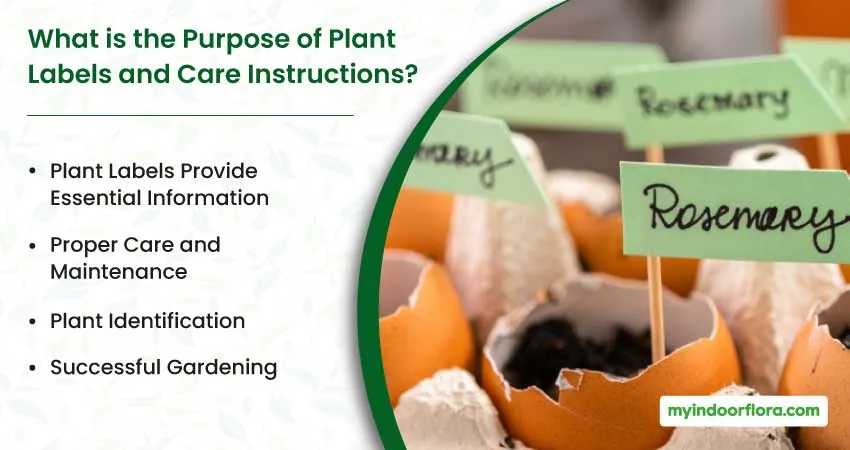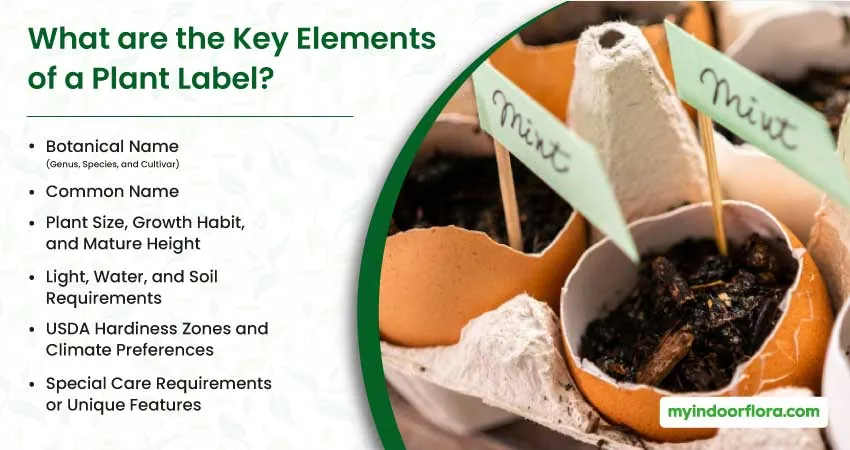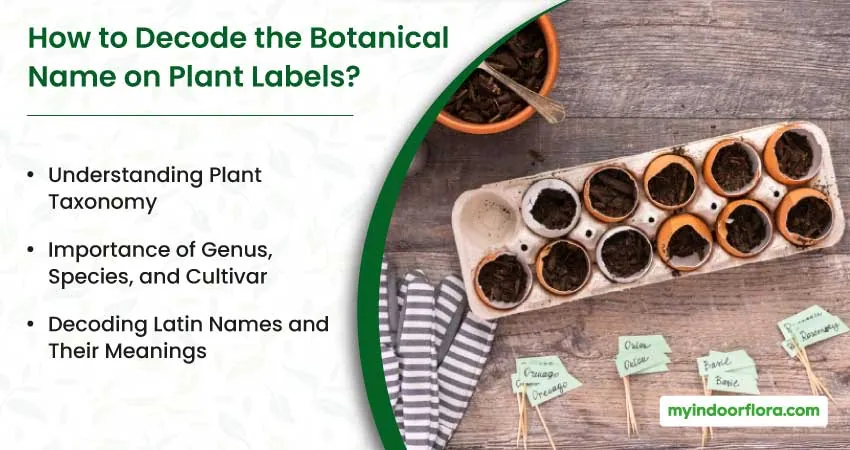With indoor gardening blooming in popularity—nearly a third of U.S. homes now nurture houseplants according to a National Gardening Survey—it’s more vital than ever to be plant-savvy. Understanding plant labels and care instructions is essential for cultivating a thriving indoor garden that enhances your living space and benefits your well-being.
This comprehensive guide, based on scientific research and expert advice, aims to equip beginners with the knowledge to decipher plant labels, comprehend the importance of botanical names, and implement proper plant care practices, such as watering, lighting, soil management, fertilizing, pruning, and pest and disease control, specifically tailored for indoor plants.
By mastering the information provided on plant labels and applying these care instructions, you will be well-prepared to create a flourishing indoor garden that not only elevates your home aesthetics but also promotes a healthier living environment.
What is the Purpose of Plant Labels and Care Instructions?

Understanding the purpose of plant labels and care instructions is crucial for every gardener, regardless of their experience level. These small but mighty tags serve several essential functions.
Plant Labels Provide Essential Information
Plant labels contain valuable information about the plant, such as its botanical name, common name, size, growth habit, mature height, light, water, soil requirements, and USDA hardiness zones. This information helps gardeners choose the right plants for their specific needs, location, and preferences.
Proper Care and Maintenance
Care instructions ensure that gardeners understand the specific needs of their plants, from watering to fertilizing, ensuring that they remain healthy and thrive in their environment. Proper care not only keeps plants looking their best but also reduces the risk of diseases and pests.
Plant Identification
Plant labels are especially helpful for gardeners who want to learn about different plant varieties, as they provide the plant’s botanical name, which is universal and allows for accurate identification.
Successful Gardening
By following the guidelines provided on plant labels and care instructions, gardeners can create a thriving garden that adds beauty and enjoyment to their lives.
What are the Key Elements of a Plant Label?

Plant labels typically contain several key pieces of information that help gardeners understand the plant’s requirements and characteristics. Here, we break down the most common elements you’ll find on plant labels.
Botanical Name (Genus, Species, and Cultivar)
The botanical name of a plant is a scientific, Latin-based name that consists of the genus, species, and cultivar. This name is used to accurately identify the plant, as common names can vary regionally and may cause confusion.
Common Name
The common name is the everyday name of the plant, which is typically easier to remember and pronounce. Common names can vary depending on the region, so they may not always be a reliable method for identifying plants.
Plant Size, Growth Habit, and Mature Height
Plant labels provide information about the plant’s size, growth habit (such as upright, spreading, or trailing), and mature height. This information is crucial when planning your garden, as it helps to determine how much space each plant will need and how it will interact with other plants in the landscape.
Light, Water, and Soil Requirements
Understanding the specific light, water, and soil needs of a plant is vital for its overall health and well-being. Plant labels typically include information about the plant’s preferred light conditions (full sun, partial shade, etc.), water requirements (drought-tolerant, moisture-loving, etc.), and soil type and pH preferences.
USDA Hardiness Zones and Climate Preferences
The USDA Hardiness Zone map is a valuable tool for gardeners, as it provides information about the average minimum winter temperature for different regions. Plant labels often include the plant’s hardiness zone range, which helps gardeners determine if a specific plant is suitable for their region’s climate.
Special Care Requirements or Unique Features
Some plants have special care requirements or unique features that may be important to consider when choosing plants for your garden. For example, a plant label might note if a plant is deer-resistant, attracts pollinators, or has specific pruning requirements. These details can be useful when selecting plants that fit your garden’s needs and your personal preferences.
How to Decode the Botanical Name on Plant Labels?

Understanding the botanical name on plant labels may seem daunting at first, but with a little knowledge of plant taxonomy, you’ll be able to decode these names with ease.
Understanding Plant Taxonomy
Plant taxonomy is the system of classifying plants into categories based on their shared characteristics. The basic hierarchy of plant classification includes kingdom, division, class, order, family, genus, and species. On plant labels, the most important elements of taxonomy you’ll encounter are the genus, species, and cultivar.
Importance of Genus, Species, and Cultivar
The genus is the first part of the botanical name and is always capitalized. It groups plants with similar characteristics together. The species is the second part of the botanical name, written in lowercase, and refers to a specific type of plant within the genus. The cultivar, which stands for “cultivated variety,” is a unique, human-developed variety within a species. Cultivars are usually written within single quotes or preceded by “cv.”
Decoding Latin Names and Their Meanings
Botanical names are derived from Latin and often provide clues about the plant’s characteristics, such as color, size, growth habit, or origin. For example, the botanical name Acer rubrum ‘October Glory’ refers to a specific cultivar of the red maple species (Acer rubrum) that has exceptional fall color in October. Learning some common Latin terms used in botanical names can make it easier to understand the information they convey.
What are the Different Types of Plant Care Instructions?

Plant care instructions are an essential part of ensuring the health and well-being of your plants. They typically cover several categories, such as watering, light, soil, fertilizing, pruning, and pest and disease management.
1. Watering Requirements
Different plants have varying water needs, and understanding these requirements is crucial for maintaining healthy plants. Overwatering and underwatering are common issues for gardeners, and knowing how much water your specific plant needs can help you avoid these problems.
Here are some tips to help you determine your plant’s watering needs.
Understanding Watering Terms
Plant labels often use terms such as “drought-tolerant” or “moisture-loving” to describe the plant’s water preferences. Drought-tolerant plants typically require less frequent watering and can withstand periods of dryness, while moisture-loving plants prefer consistently moist soil and may require more frequent watering.
Signs of Overwatering and Underwatering
Recognizing the signs of overwatering and underwatering is crucial for adjusting your watering practices accordingly. Overwatered plants may exhibit yellowing leaves, root rot, and wilting, while underwatered plants may have dry, brown leaf tips, leaf drop, and stunted growth.
Tools and Techniques for Proper Watering
Using the right tools and techniques can make it easier to provide your plants with the appropriate amount of water. A soil moisture meter can help you determine when it’s time to water, and using a watering can or soaker hose can ensure that the water reaches the plant’s roots effectively.
2. Light Preferences
Plants have different light requirements, from full sun to full shade. Providing the right amount of light is essential for the proper growth and development of your plants. Too much or too little light can lead to issues such as leggy growth or failure to bloom.
Here are the various light requirements you may encounter on plant labels and how to provide these conditions for your plants.
Recognizing Full Sun, Partial Sun, Partial Shade, and Full Shade
- Full sun: Plants that require full sun need at least 6 hours of direct sunlight per day. These plants typically perform best in locations with unobstructed sunlight, such as open areas or south-facing spots in your garden.
- Partial sun: Partial sun plants need 4 to 6 hours of direct sunlight per day. East-facing or west-facing locations are often suitable for these plants.
- Partial shade: Plants that prefer partial shade also need 4 to 6 hours of sunlight per day, but they benefit from protection from the intense midday sun. Dappled shade or locations with morning sun and afternoon shade are ideal for these plants.
- Full shade: Full shade plants can thrive with less than 3 hours of direct sunlight per day or in areas with consistent dappled shade. These plants are well-suited for locations under trees or on the north side of buildings.
How to Provide the Right Light Conditions
To provide the right light conditions for your plants, assess your garden’s sunlight exposure and choose plants that match the available light. You can also make adjustments to your garden, such as pruning trees to increase sunlight or adding shade cloth to protect sensitive plants.
How to Identify if Your Plant is Receiving Too Much or Too Little Light
Signs that your plant is receiving too much light may include scorched leaves, faded or bleached foliage, and a lack of blooms. Conversely, too little light can cause leggy growth, weak stems, and reduced flowering.
Adjust your plant’s location or light conditions accordingly to address these issues.
3. Soil Types and pH Levels
Soil is the foundation of your garden, and different plants have specific preferences for soil type, texture, and pH levels. Understanding these requirements is essential for creating the ideal growing conditions for your plants.
Importance of Soil Type, Texture, and pH Levels
Different plants have specific preferences for soil type (such as sandy, loamy, or clay), texture (the balance of sand, silt, and clay particles), and pH levels (the measure of soil acidity or alkalinity). Matching your plant’s preferences with the appropriate soil can significantly impact its growth and overall health.
Common Soil Amendments for Specific Plant Needs
To create the ideal soil conditions for your plants, you may need to amend your garden soil with organic matter, such as compost, peat moss, or aged manure. These amendments can improve soil structure, increase nutrient availability, and adjust pH levels to better suit your plant’s needs.
Signs of Improper Soil Conditions and How to Correct Them
If your plant is not thriving, improper soil conditions may be the cause. Signs of poor soil conditions can include stunted growth, yellowing leaves, or a lack of flowering. To correct these issues, test your soil to determine its pH and nutrient levels, and make adjustments accordingly with soil amendments or by selecting plants better suited to your garden’s existing soil conditions.
4. Fertilizing Needs
Fertilizing provides plants with the nutrients they need to grow and thrive. Different plants have varying nutrient requirements, and understanding these needs helps you select the appropriate fertilizer and application method.
Here are some tips for choosing the right fertilizer and application method for your plants.
Understanding Fertilizer Types and Nutrient Ratios
Fertilizers come in various forms, such as granular, liquid, or slow-release, and contain different nutrient ratios. These ratios are represented by three numbers (e.g., 10-10-10), which indicate the percentage of nitrogen (N), phosphorus (P), and potassium (K) in the fertilizer. Different plants have specific nutrient requirements, and selecting the appropriate fertilizer is essential for their overall health.
Fertilizing Frequency and Application Methods
How often and how much you fertilize your plants will depend on their specific needs and the type of fertilizer you choose. Some plants may benefit from monthly applications, while others may only need fertilizing once or twice per growing season. Follow the instructions on the fertilizer label and adjust your practices based on your plant’s appearance and growth.
Signs of Overfertilizing and Underfertilizing
Recognizing the signs of overfertilizing and underfertilizing can help you adjust your fertilizing practices accordingly. Overfertilized plants may exhibit burnt leaf tips, reduced growth, or an abundance of foliage at the expense of flowers or fruit. Underfertilized plants may have pale or yellowing leaves, poor growth, and a lack of blooms. Monitoring your plants and adjusting your fertilizing practices can help prevent these issues.
5. Pruning and Maintenance
Proper pruning and maintenance are essential for maintaining healthy, attractive plants. Some plants have specific pruning requirements, while others may need little or no pruning at all. Understanding the needs of your plants will help you keep them looking their best.
Here are some tips for pruning and maintaining your plants.
Understanding Pruning Techniques and Timing
Different plants have specific pruning needs and techniques, such as thinning, heading back, or pinching. Pruning at the right time is also crucial, as some plants should be pruned in the dormant season, while others require pruning after flowering. Research your specific plant’s pruning requirements to ensure that you are using the correct techniques and timing.
Tools for Proper Pruning and Maintenance
Using the right tools for pruning and maintenance is essential for ensuring clean, healthy cuts and minimizing the risk of damage to your plants. Some common pruning tools include bypass pruners, anvil pruners, loppers, and pruning saws. Keep your tools clean and sharp to prevent the spread of diseases and ensure precise cuts.
Signs of Improper Pruning and How to Correct Them
Improper pruning can lead to a variety of issues, such as reduced flowering, poor growth, or increased susceptibility to pests and diseases. If your plant is not thriving, assess your pruning practices and make adjustments as needed, such as changing the timing of your pruning or using the appropriate pruning techniques for your plant.
6. Pests and Diseases
All plants are susceptible to pests and diseases, and understanding the common issues that affect your plants is essential for prevention and management. Early detection and treatment can help save your plants from serious damage.
Here are some strategies for preventing and addressing common garden pests and diseases.
Monitoring and Early Detection
Regularly inspect your plants for signs of pests and diseases, such as discolored leaves, holes in foliage, or the presence of insects. Early detection can make it easier to address issues before they become severe.
Prevention and Cultural Practices
Preventive measures, such as maintaining proper watering and fertilizing practices, can help keep your plants healthy and more resistant to pests and diseases. Cultural practices, such as rotating crops, selecting disease-resistant varieties, and properly spacing plants to ensure good air circulation, can also help reduce the risk of pest and disease issues.
Biological and Chemical Controls
When pests or diseases do appear in your garden, consider using biological controls, such as introducing beneficial insects or using microorganisms that target specific pests. Chemical controls, such as insecticides or fungicides, should be used as a last resort and applied judiciously to minimize their impact on beneficial organisms and the environment.
Integrated Pest Management (IPM)
Integrated Pest Management (IPM) is an approach that combines multiple strategies, such as monitoring, prevention, cultural practices, biological controls, and chemical controls, to manage pests and diseases in a way that minimizes harm to the environment and human health. Adopting IPM practices in your garden can help you manage pest and disease issues more effectively and sustainably.
Conclusion
Understanding the information provided on plant labels is crucial for selecting the right plants for your garden and ensuring their proper care. Familiarizing yourself with the various terms and care instructions can help you create a thriving garden that meets your needs and preferences. Keep these tips in mind as you navigate the world of plant labels and embark on your indoor gardening journey.
